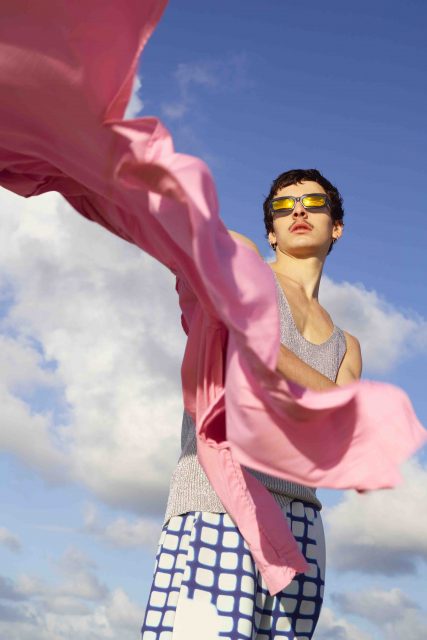On the final day of this season’s phygital fashion week schedule, Miuccia Prada presented a paean to polarity: a collection which explored how women might dress for different occasions in their lives – whether running track, racing to a gala, or perhaps doing both at once. Opening with Lila Moss’s runway debut, and containing clothing fit for every eventuality, it represented a return to Miu Miu’s core codes both visually and philosophically: a ’90s-inflected take on feminine multiplicity. Here’s what you need to know.
It leant into the community spirit of the digital age
Ordinarily, the Tuesday of Paris Fashion Week would see the industry on its last legs – but with circumstances what they are, instead editors gathered at laptops to watch Miu Miu from their living rooms. However, rather than sitting in isolation, the brand enlisted friends and family across the globe to remotely zoom into the audience, with plenty of familiar faces (Elle Fanning, Chloë Sevigny, Gabrielle Union), appearing on digital screens that lined the runway, alongside live viewing parties which proliferated across social media. “Communities of women have always been integral to the spirit and identity of Miu Miu: their nurturing and support of one another, their pursuit of shared values and goals,” said the brand. “This season, those communities of women are also intrinsic to the show itself.”
The Miu Miu brand has long championed that collective energy through occasions like the Miu Miu Club (a three day salon back in 2012 which remains everyone’s all-time favourite fashion event), or its Women’s Tales screenings, which showcase specially-commissioned shorts by female directors across the globe. So editors were dispatched boxes of Marchesi sweets, Miu Miu-stamped notepads and pencils, and pastel pink-wrapped bunches of flowers with which to communally immerse themselves in the spirit of things – and then, all together, press play.
The showspace was staged as a sports stadium
Those who have taken up exercise in quarantine will be delighted: this season, Miu Miu embedded both its showspace and its clothing within the aesthetic signifiers of sports. On the stadium-like runway appeared an encyclopaedic array of athleisure: ’70s ombré tracksuit tops; towelled, teal two-pieces channelling the composed glamour of ’80s tennis; a wealth of ergonomic ’90s minimalism (much of this collection spoke to Miu Miu’s early years). There were racing stripes and racer backs; sports shoes spliced into kitten heels. Whatever game you play, you’ll be well served for the season ahead – and, if spectator sports remain off-limits, at least your loungewear will get an upgrade.
But there was plenty of prettiness, too
“This Miu Miu collection is about polarity – these are polar times. Everything is opposite,” explained Miuccia Prada. “Sportswear and evening wear, a moment of reality, a moment of fantasy. In life, you need both.” At Miu Miu, the designer has often explored girlishness within a highly cerebral framework: it’s less about simply offering bedazzled, beribboned dresses, and more about exploring the aesthetic conventions of femininity. “You are never one woman – you are many,” she continued. So, alongside the luxe athleisure appeared layers of shimmering transparencies, or pretty pink ruffled shirts paired with track pants. Utilitarian zip-ups were worn with full, ’50s, bow-bedecked skirts, and evening dresses, dripping with jewels, were dressed down with trainers. There were enough jewelled numbers to satisfy those yearning for an occasion – but wearing your sparkling micro mini with a striped polo looks far fresher.
Clothing was showcased as a tool for self-expression
There’s a famous John Berger quote which will be familiar to anyone with so much as an A-Level in history of art: “Men act and women appear. Men look at women. Women watch themselves being looked at.” Reflecting a world that conditions women to be constant subjects of observation was one of Miu Miu’s reasons behind creating a stadium showspace. “As athletes act out their movements for an audience, they transform these spaces not only into a palace of sports, but an arena of observation,” said the brand. “The show and collection both draw on the mutual language of sport and of the fashion show, finding parallels in these two forms of spectacle, of performances observed.”
“The reason why people dress is sometimes to please, sometimes to be sexy, sometimes to be socially relevant, sometimes for a job,” said Mrs Prada. “The way you present yourself – the clothes are important because they define you in a second. Clothes are a tool for that message. The first spectator of yourself is you.” In a cultural climate where to be seen, virtually or otherwise, appears of paramount importance, that final sentiment holds particular resonance. Yes, your clothes might make particular impressions on other people – but even more important is how they affect your own sense of self.
Mixing and matching was key
If any approach has been rendered irrelevant by 2020, it is that of constantly wearing a full, new season look – that it’s never been the way anyone actually dresses has been thrown into sharp relief by conversations about consumption, and the fact that red-carpet fantasies have gone out the window. Here, mixing and matching – of different eras, prints, genres – was key, and spoke to the way women dress today. But for Mrs Prada, that stylistic eclecticism spoke to more than just sheer practicality. “There is a focus on separates, because then you can be a mix of different women,” she said. “Provocative, conservative, revealed, concealed.” Here were plenty of pieces that could seamlessly integrate into your existing wardrobe, wherever you’re going (or not, as the case may be).
Read Next
Dries Van Noten Believes in “Beauty That Evokes Energy” for Spring/Summer 2021
Editor
Olivia Singer

